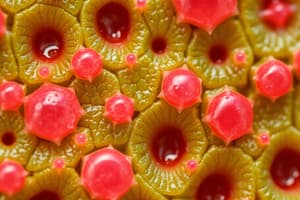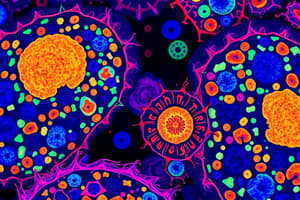Podcast
Questions and Answers
What distinguishes the granular layer of the epidermis from the Malpighian layer?
What distinguishes the granular layer of the epidermis from the Malpighian layer?
- The granular layer is mitotically active, continuously dividing to produce new cells, unlike the Malpighian layer.
- The granular layer consists of cells filled with granules of the protein keratin and does not divide, whereas the Malpighian layer is mitotically active. (correct)
- The granular layer is characterized by the presence of integrin proteins binding cells to the basal lamina, unlike the Malpighian layer.
- The granular layer contains melanocytes that transfer pigment to keratinocytes, a feature absent in the Malpighian layer.
How does the development of hair follicles begin in mammals?
How does the development of hair follicles begin in mammals?
- With an aggregation of cells in the basal layer of the epidermis, directed by dermal fibroblast cells. (correct)
- With the formation of the sebaceous glands.
- With the differentiation of melanocytes.
- With the cornification of cells in the outer epidermal layer.
What is the role of melanocytes in the epidermis?
What is the role of melanocytes in the epidermis?
- To produce keratin granules within epidermal cells.
- To transfer pigment sacs (melanosomes) to the developing keratinocytes. (correct)
- To stimulate the division of basal cells.
- To form the cornified layer of dead cells.
What is the primary distinction between vellus and terminal hair?
What is the primary distinction between vellus and terminal hair?
What happens to epidermal cells as they become committed to differentiation?
What happens to epidermal cells as they become committed to differentiation?
Sonic hedgehog acts as an activator in the reaction-diffusion process responsible for the patterning of cutaneous appendages. How does it function?
Sonic hedgehog acts as an activator in the reaction-diffusion process responsible for the patterning of cutaneous appendages. How does it function?
What is vernix caseosa, and how does it form?
What is vernix caseosa, and how does it form?
What is the primary function of the periderm?
What is the primary function of the periderm?
What is the significance of TGF-α as an autocrine growth factor in the epidermis?
What is the significance of TGF-α as an autocrine growth factor in the epidermis?
In the context of hair follicle development, what role do dermal papilla cells play?
In the context of hair follicle development, what role do dermal papilla cells play?
How does KGF (keratinocyte growth factor) influence epidermal production, and where is it produced?
How does KGF (keratinocyte growth factor) influence epidermal production, and where is it produced?
What is the Malpighian layer composed of, and what is its primary function?
What is the Malpighian layer composed of, and what is its primary function?
What is the immediate fate of the lanugo hairs that appear in the human embryo?
What is the immediate fate of the lanugo hairs that appear in the human embryo?
BMP4 and BMP2 are paracrine factors believed to act as inhibitors in the patterning of cutaneous appendages. What is their suggested function?
BMP4 and BMP2 are paracrine factors believed to act as inhibitors in the patterning of cutaneous appendages. What is their suggested function?
How does the overexpression of TGF-α contribute to the development of psoriasis?
How does the overexpression of TGF-α contribute to the development of psoriasis?
What is the origin and function of the basal layer (or stratum germinativum) of the epidermis?
What is the origin and function of the basal layer (or stratum germinativum) of the epidermis?
How does the signaling between the epidermis and dermis lead to the formation of cutaneous appendages?
How does the signaling between the epidermis and dermis lead to the formation of cutaneous appendages?
What role do integrin proteins play in the epidermal stem cells of the Malpighian layer, and how does this change as the cells differentiate?
What role do integrin proteins play in the epidermal stem cells of the Malpighian layer, and how does this change as the cells differentiate?
If the gene encoding KGF is fused with the keratin 14 promoter in transgenic mice, what is the likely outcome regarding hair follicle development?
If the gene encoding KGF is fused with the keratin 14 promoter in transgenic mice, what is the likely outcome regarding hair follicle development?
How does the balance between Sonic hedgehog and BMPs contribute to the patterned arrangement of cutaneous appendages?
How does the balance between Sonic hedgehog and BMPs contribute to the patterned arrangement of cutaneous appendages?
Flashcards
Periderm
Periderm
Temporary outer layer of embryonic epidermis, shed after the inner layer differentiates.
Basal Layer
Basal Layer
The innermost epidermal layer, also known as stratum germinativum.
Spinous Layer
Spinous Layer
Epidermal layer outer to the basal layer.
Malpighian Layer
Malpighian Layer
Signup and view all the flashcards
Granular Layer
Granular Layer
Signup and view all the flashcards
Keratinocytes
Keratinocytes
Signup and view all the flashcards
Cornified Layer (Stratum Corneum)
Cornified Layer (Stratum Corneum)
Signup and view all the flashcards
Melanocytes
Melanocytes
Signup and view all the flashcards
Autocrine Growth Factor
Autocrine Growth Factor
Signup and view all the flashcards
Dermal papilla
Dermal papilla
Signup and view all the flashcards
Hair Germ
Hair Germ
Signup and view all the flashcards
Sebum
Sebum
Signup and view all the flashcards
Sebaceous glands
Sebaceous glands
Signup and view all the flashcards
Lanugo
Lanugo
Signup and view all the flashcards
Vellus
Vellus
Signup and view all the flashcards
Study Notes
Origin of Epidermal Cells
- Presumptive epidermis forms after neurulation, initially one cell layer thick.
- It soon becomes two-layered in most vertebrates.
- The outer layer is a temporary covering called the periderm, is shed when the inner layer forms the true epidermis.
- The inner layer, or basal layer (stratum germinativum), is a germinal epithelium.
- The basal layer produces the spinous layer, and both epidermal layers are known as the Malpighian layer.
- The cells of the Malpighian layer divide to produce cells of the granular layer of the epidermis, whose cells contain granules of the protein keratin.
- Granular layer cells, unlike Malpighian layer cells, stop dividing and start differentiating into keratinocytes.
- As keratinocytes age and migrate outward, the keratin granules become more prominent and form cells of the cornified layer (stratum corneum).
- Cells of the cornified layer become flattened sacs of keratin protein with nuclei pushed to one edge.
- The cornified layer varies in depth, usually 10-30 cells thick.
- Outer cells of the cornified layer are shed shortly after birth, replaced by new cells from the granular layer.
- Throughout life, dead keratinized cells of the cornified layer shed at a rate of about 1.5 grams per day in humans.
- The mitotic cells of the Malpighian layer are the source of the new cells.
- Melanocytes from the neural crest reside in the Malpighian layer, where they transfer pigment sacs (melanosomes) to developing keratinocytes.
- Epidermal stem cells of the Malpighian layer bind to the basal lamina via integrin proteins.
- Cells down-regulate and lose integrins as they commit to differentiate and migrate into the spinous layer.
Growth Factors and Epidermal Development
- Transforming growth factor-α (TGF-α) stimulates epidermal development.
- TGF-α is an autocrine growth factor made by basal cells to stimulate their own division.
- Dysregulation of autocrine growth factors can lead to rapid cell production.
- An adult skin cell takes roughly 8 weeks to reach the cornified layer and remains there for about 2 weeks.
- In psoriasis, cells spend only 2 days in the cornified layer, resulting in excessive exfoliation.
- Psoriasis has been linked to TGF-α overexpression, secondary to inflammation.
- Transgenic mice with the TGF-α gene linked to a keratin 14 promoter develop scaly skin, stunted hair growth, and excess keratinized epidermis.
- Keratinocyte growth factor (KGF; fibroblast growth factor 7) is another growth factor needed for epidermal production.
- KGF is a paracrine factor produced by fibroblasts of the dermis.
- It is received by the basal cells of the epidermis, thought to regulate their proliferation.
- Transgenic mice with KGF made autocrine develop a thickened epidermis, baggy skin, too many basal cells, and no hair follicles.
- In transgenic mice, basal cells are forced into the epidermal pathway of differentiation instead of generating hair follicles.
Cutaneous Appendages
- Epidermis and dermis interact to create sweat glands and cutaneous appendages (hairs, scales, or feathers).
- The first sign of hair follicle primordium (hair germ) formation is an aggregation of cells in the epidermis basal layer.
- This aggregation is directed by underlying dermal fibroblast cells.
- Dermal signals likely cause stabilization of β-catenin in the ectoderm.
- Basal cells elongate, divide, and sink into the dermis.
- Dermal fibroblasts form a dermal papilla beneath the hair germ in response.
- The dermal papilla stimulates basal stem cells to divide more rapidly.
- Basal cells produce postmitotic cells that differentiate into the keratinized hair shaft.
- Melanoblasts differentiate into melanocytes and transfer pigment to the hair shaft.
- Two epithelial swellings grow on the side of the hair germ.
- The lower swelling cells may retain stem cells that regenerate the hair shaft when shed.
- The cells of the upper bulge form the sebaceous glands, which produce sebum.
- Sebum mixes with shed peridermal cells to form the vernix caseosa around the fetus at birth in many mammals, including humans.
- Pluripotent epidermal stem cells can become epidermis, sebaceous gland, or hair shaft cells.
Hair Types
- Lanugo is the first type of hair in the human embryo, thin and closely spaced.
- Lanugo is usually shed before birth and replaced by vellus.
- Vellus is short and silky and remains on areas usually considered hairless.
- Vellus can give way to terminal hair in some areas.
- Follicles that produced vellus can later form terminal hair and revert to vellus production.
- Armpit follicles produce vellus until adolescence, then produce terminal shafts.
- In normal masculine pattern baldness, scalp follicles revert to producing unpigmented vellus hair.
Patterning of Cutaneous Appendages
- Cutaneous appendages do not grow randomly over the body.
- Spaces between appendages (e.g., on the scalp) are similar from region to region.
- A reaction-diffusion process may be responsible for this pattern.
- Sonic hedgehog is the activator, a paracrine factor that acts locally without much diffusion.
- BMP4 or BMP2 is believed to be the inhibitor, both paracrine factors with a greater range of diffusion.
- BMPs may prevent dermal fibroblasts from aggregating.
- Sonic hedgehog may support the formation and retention of the dermal papilla.
Studying That Suits You
Use AI to generate personalized quizzes and flashcards to suit your learning preferences.




